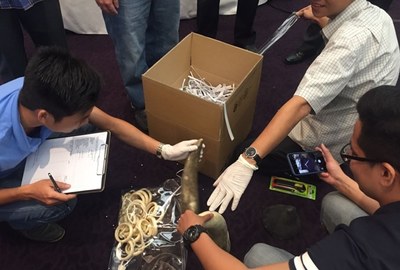New courses on risk profiling of wildlife contraband in Lao PDR and Viet Nam
To better support Customs officers in responding to these challenges, a new four-day training course on “Risk Profiling to Enhance Interception of Illegal Wildlife Trade” was developed and rolled out both in Lao PDR and in Viet Nam. A total of 50 participants completed the courses, including 40 customs officers and other representatives from police and other agencies.
The training courses were the result of cooperation between the United Nations Office on Drugs and Crime (UNODC) and USAID Wildlife Asia , and organised in partnership with the General Department of Viet Nam Customs and with the Lao Customs Department. Within UNODC, there was collaboration between two programmes: the Global Programme for Combating Wildlife and Forest Crime, and the UNODC/WCO Container Control Programme (CCP).
During the courses, participants discussed wildlife risk indicators that could be applied for air passengers, air cargo and sea cargo. Participants also completed a series of practical exercises involving examination of shipping documents to target wildlife smuggling, and special investigation techniques that can be applied following a seizure.
“In recent years in Viet Nam, Customs officers have made many large seizures of wildlife and timber products at airports and seaports across the country,” said Mr. Duong Van Tam, Deputy Director of International Cooperation at the General Department of Viet Nam Customs. “But one of the most challenging issues we face in detecting wildlife smuggling is the increasingly sophisticated concealment methods that criminals are using.”
This has been demonstrated in several major seizures in Viet Nam in recent years. For example, within one month in October 2016, Customs officers at Cat Lai Seaport in Ho Chi Minh City made a series of four major seizures totaling approximately 4 tonnes of ivory and 277kg of pangolin scales, where the ivory was concealed inside hollowed-out blocks of timber, which were sealed with plaster and nailed together. In another instance elephant tusks and rhino horns were concealed within fake marble rocks.
Lao PDR is known as a transit country for ivory, rhino horn, and other wildlife products, but compared to Viet Nam, the Lao Customs Department has made far fewer wildlife seizures. The first-ever recorded seizure of ivory in Lao PDR was made in September 2015 by Customs officers at Wattay International Airport in Vientiane.
“Capacity building in the area of detecting wildlife smuggling is greatly needed in Lao PDR, and it is the first time our Customs officers have received this type of training”, said Mr. Sompith Sengmanyvong, Deputy Director General of the Lao Customs Department under the Ministry of Finance. “This course has provided important support to improve our understanding of wildlife smuggling trends and risk indicators, and how risk assessment, international cooperation and information sharing can support customs officers in law enforcement efforts to counter wildlife crime.”
“The response from Lao and Vietnamese participants has been very positive,” said Mr. Salvatore Amato, Law Enforcement Specialist for USAID Wildlife Asia. “We hope that it will lead to stronger results at the operational level – not only in terms of detecting and seizing wildlife contraband – but also in conducting further investigations and controlled deliveries, where appropriate, to disrupt the organised criminal networks that are behind the wildlife trafficking.”
“Several indicators suggest that Laos has become a market of illegal wildlife products for foreign buyers” said Mr. Giovanni Broussard, Regional Coordinator of the UNODC Global Programme for Combating Wildlife and Forest Crime. “Therefore all relevant authorities must be equipped to respond quickly to a crime that changes trends, patterns and modus operandi very dynamically”
The training course in Viet Nam was conducted in Ho Chi Minh City from September 26-29, 2017, and the training course in Lao PDR was conducted in Vientiane from October 2-5, 2017.


